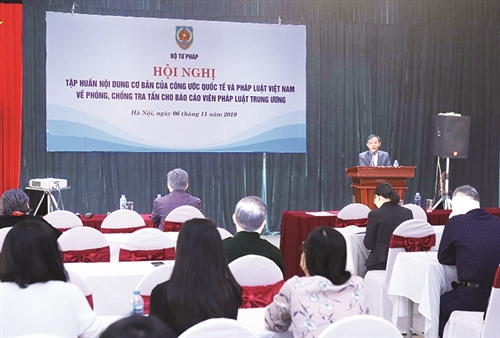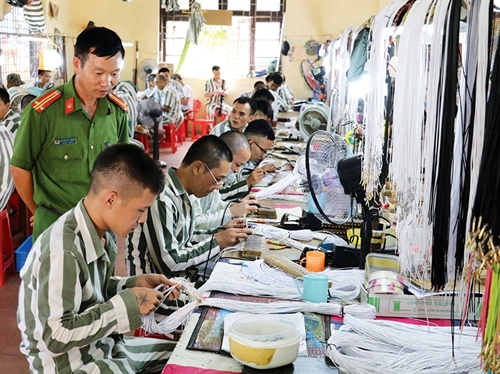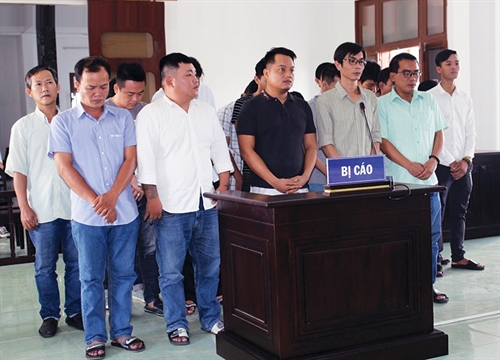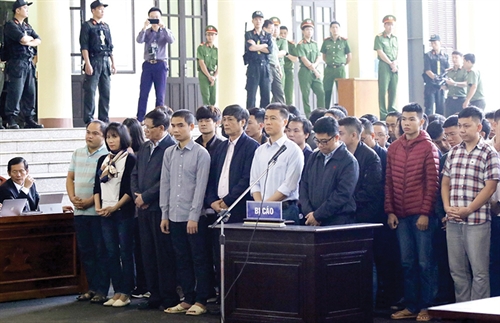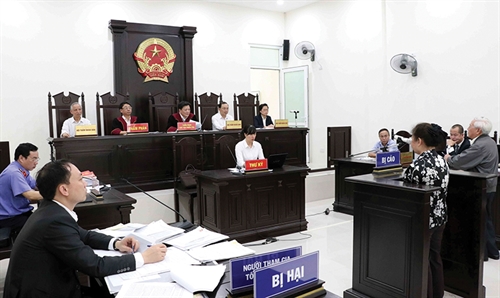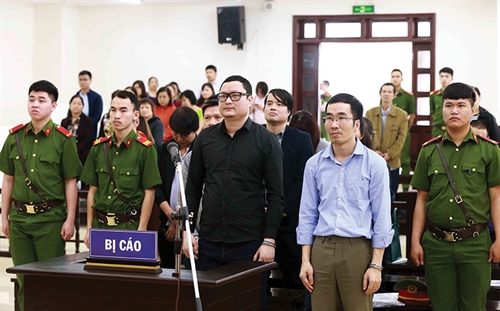The 2015 Penal Code prescribes heavy fines for corporate legal persons’ crimes violating regulations on management and protection of endangered, precious and rare wild animals, ranging from VND 300 million to VND 15 billion[1]. This shows that Vietnam is always aware of the nature and danger of these crimes to the ecological environment.
Nguyen Phuong Anh, LL.M.
Department of Criminal and Administrative Legislation
Ministry of Justice
The Penal Code’s provisions on corporate offenders committing crimes against wildlife protection regulations
The 2015 Penal Code (revised in 2017) (the Code) for the first time subjects corporate legal persons to penal liability for 33 crimes against regulations on economic order, environmental protection, and public order and safety[2]. Unlike many developed countries around the world that provide a relatively wide scope of penal liability of legal persons, Vietnam’s criminal law only prescribes penal liability of corporate legal persons, mainly in Chapter XI of the Code and some relevant provisions.
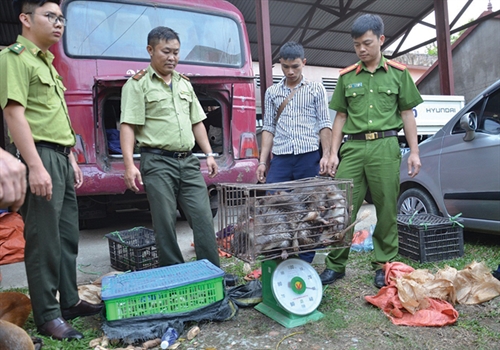 |
| Dien Bien province’s policemen hand over illegally transported precious and rare animals to forest protection officers for further investigation__Photo: VNA |
Under the 2015 Civil Code, an institution is recognized as a legal person when it fully satisfies four conditions: (i) being lawfully established in accordance with law;
(ii) having an organizational structure[3]; (iii) having assets independent from other natural and legal persons and holding liability by recourse to its assets; and (iv) participating independently in legal relations in its own name[4].
The Civil Code divides legal persons into corporate legal persons and non-corporate legal persons[5]. A corporate legal person is defined as a legal person whose primary purpose is to seek profits which shall be distributed to its members. Corporate legal persons include enterprises and other business institutions.
As a result, corporate legal persons that may bear penal liability under the Code are entities with the legal person status and a profit-driven purpose.
In other words, the Code does not subject the following non-corporate legal persons to possible penal liability: state agencies, people’s armed forces units, political organizations, socio-political organizations, socio-political-professional organizations, social organizations, socio-professional organizations, charitable organizations, and social enterprises. The reason is that operations of these legal persons are funded by the state budget.
Penal liability of legal persons for crimes against regulations on protection of endangered, precious and rare wild animals
As per the Code, the conditions for a corporate legal person to bear penal liability for a crime include facts that the crime is committed in its name and for its benefits, the crime is committed under its instructions, administration or approval, and the statute of limitations for initiation of a criminal case against it has not expired[6].
In reality, legal persons cannot commit crimes by themselves. Crimes of legal persons must be committed by individuals. In other words, penal liability of legal persons and their affiliated individuals in criminal cases is inseparable. If a legal person is identified to bear penal liability in a case, one or more individuals involved in decision-making process or being representatives of the legal person cannot escape criminal prosecution. This prevents individuals, e.g., heads of legal persons or decision makers who stand behind such legal persons, from shirking criminal liability examination and prosecution. The Code therefore stipulates that, the fact that a corporate legal person bears penal liability does not exclude penal liability of individuals[7].
In case of a crime-committing legal person, there may be one or more individuals involved, including the director/head, division/section heads and staff members. The director is the head of a legal person who has authority to issue orders or directives. Division/section heads can facilitate or provide necessary tools and convey the director’s orders to staff members who directly commit the crime. In this case, if all the aforesaid conditions are satisfied (the crime is committed on behalf of the legal person and for its benefits and under its or its head’s instructions and management, then criminal prosecution is imposed on that legal person. However, for the three types of individuals mentioned above, is criminal prosecution imposed on all three or only for the director/head of the legal person?
In principle, the head of a legal person, who is the at-law representative of that legal person and has authority to issue orders or directives for crime commission, would be the individual prosecuted for penal liability. However, in case staff members directly commit the crime or division/section heads facilitate crime commission or convey orders of the director/head (their superior) for crime commission, would these individuals face criminal prosecution? In case the head of a legal person is a group of individuals (such as the Board of Directors of a joint-stock company), separate liabilities of the chairperson and members of the Board of Directors need to be examined.
We propose examining penal liability of the aforesaid individuals on a case-by-case basis, based on the consensus in their will to commit one or more criminal acts that causes the legal person commit the crime and face penal liability. If there is an evidence proving that these individuals did not know or opposed the criminal act of the legal person, even though they hold executive or managerial positions in the legal person, such as members of the Board of Directors, they should be considered not to bear penal liability for the same crime as the legal person. However, prosecution for penal liability of these individuals may still be applied for the reason that they need to bear responsibility for acts of the legal person.
In our opinion, both cases mentioned above are directly related to criminal acts of a legal person. Therefore, both can be considered crime perpetrators and undoubtedly should be charged with the same crime as the legal person, except in case of exemption from penal liability for those executing orders of commanders or superiors[8].
Wild animals and endangered, precious and rare wild animals are under different levels of protection under the Code, so penalties to be imposed for crimes against them are divided into different levels. In case a corporate legal person commits a crime in violation of regulations on management and protection of wild animals, it shall be liable to a fine, operation suspension for a definite period of time, or permanent shutdown. In addition, it may also face additional penalties such as additional fine or prohibition from doing business in certain fields or from raising capital for a definite period of time. The most severe penalty for crimes of corporate legal persons is permanent shutdown.
As per the Code, permanent shutdown means termination of operation of a corporate legal person in one or more than one field in which it commits a crime, causing or practically likely to cause damage the lives of many people, causing environmental incidents, or causing adverse impacts on security or social order and safety, and such consequences cannot be remedied. Permanent shutdown is also applied to any corporate legal person that is established for the sole purpose of committing crimes[9].
Corporate legal persons that commit crimes in violation of regulations on management and protection of wild animals, as prescribed in Article 234 of the Code, are liable to a fine of between VND 300 million and VND 6 billion, face operation suspension for a definite period of time or permanent shutdown, depending on severity of their criminal acts. The principal penalties for a corporate legal person’s crime are divided into four levels: (i) a fine of between VND 300 million and VND 1 billion, for the cases specified in Clause 1 of Article 234; (ii) a fine of between VND 1 billion and VND 3 billion, for the cases specified at Points a, d, dd, e, g, h and i, Clause 2 of Article 234[10]; (ii) a fine of between VND 3 billion and VND 6 billion or operation suspension for between six months and three years, for the cases specified in Clause 3 of Article 234; and (iv) permanent shutdown, the highest penalty to be imposed for the cases specified in Article 79 of the Code.
The definitions of “prohibited hunting gear” and “hunting during no-hunting periods” are pursuant to Clauses 1, 2 and 3, Article 3 of Resolution 05/2018/NQ-HDTP dated November 5, 2018, of the Judicial Council of the People’s Supreme Court, guiding the application of Articles 234 and 244 of the Penal Code[11]. Furthermore, crime-committing corporate legal persons might also face additional penalties including a fine of between VND 50 million and VND 200 million, prohibition from doing business in certain fields or or from raising capital for between one year and three years.
Compared to the aforesaid crimes violating regulations on management and protection of wild animals, corporate legal persons committing crimes in violation of regulations on protection of endangered, precious and rare animals under Article 244 of the Code might face more severe punishments. Such expresses the State’s policy to strictly protect endangered, precious and rare animals prioritized for protection and animals of Group IB and Appendix I to CITES[12]. The principal penalties include fine, operation suspension for a definite period of time and permanent shutdown. On a case-by-case basis, a fine of between VND 1 billion and VND 15 billion, operation suspension for between six months and three years, or permanent shutdown may be imposed. Like penalties for crimes violating regulations on management and protection of wild animals, principal fines for a corporate legal person are divided into four levels: (i) a fine of between VND 1 billion and VND 5 billion, for the cases specified in Clause 1 of Article 244; (ii) a fine of between VND 5 billion and VND 10 billion, for the cases specified at Points a, b, c, d, dd, g, h and i, Clause 2 of Article 244[13]; (iii) a fine of between VND 10 billion and under VND 15 billion or operation suspension for a definite period of time, for the cases specified in Clause 3 of Article 244; and (iv) permanent shutdown, the highest penalty to be imposed for the cases specified in Article 79 of the Code.
The additional fine to be imposed on a corporate legal person under Article 244 of the Code is also more severe, ranging from VND 300 million to VND 600 million, in addition to prohibition from doing business in certain fields or from raising capital for between one year and three years.
Some recommendations
The Code’s provisions on criminal liability of corporate legal persons are a step forward in criminal justice and make a significant contribution to the prevention and criminalization of socially dangerous acts of legal persons. However, since this is the first time penal liability of legal persons is regulated, there remain some issues requiring further research and improvement in the Code, together with prescription of criminal acts in laws other than the Code to ensure timely handling of corporate crimes[14]. Types of legal persons that are subject to penal liability should also be studied for more specific provisions. As the study of penal liability of legal persons has been conducted for the first time, it is necessary to narrow down those among them, i.e., enterprises, that are capable of committing crimes first. In the future, penal liability should also be examined with regard to other types of enterprises, including those without the legal person status.
Generally speaking, the revision of the Code helps ensure stricter punishment for crimes related to endangered, precious and rare wild animals. However, under the Code, compared to 31 other crimes for which corporate legal persons may bear penal liability, there is no specific provision on principles of prosecution against, and conditions for examination of penal liability of, corporate legal persons committing crimes violating regulations on protection of endangered, precious and rare wild animals. Nevertheless, the fact that fines to be imposed for these wildlife-related crimes are hefty ranging from VND 300 million to VND 15 billion shows that the nation is fully aware of the nature and danger of these crimes and importance of strict prosecution against them, especially when perpetrated by corporate legal persons.-
Cases of using prohibited hunting gear, hunting in no-hunting areas or during no-hunting periods, trading or transportation across the border are specified in Resolution 05/2018/NQ-HDTP dated November 5, 2018, of the Judicial Council of the People’s Supreme Court.


